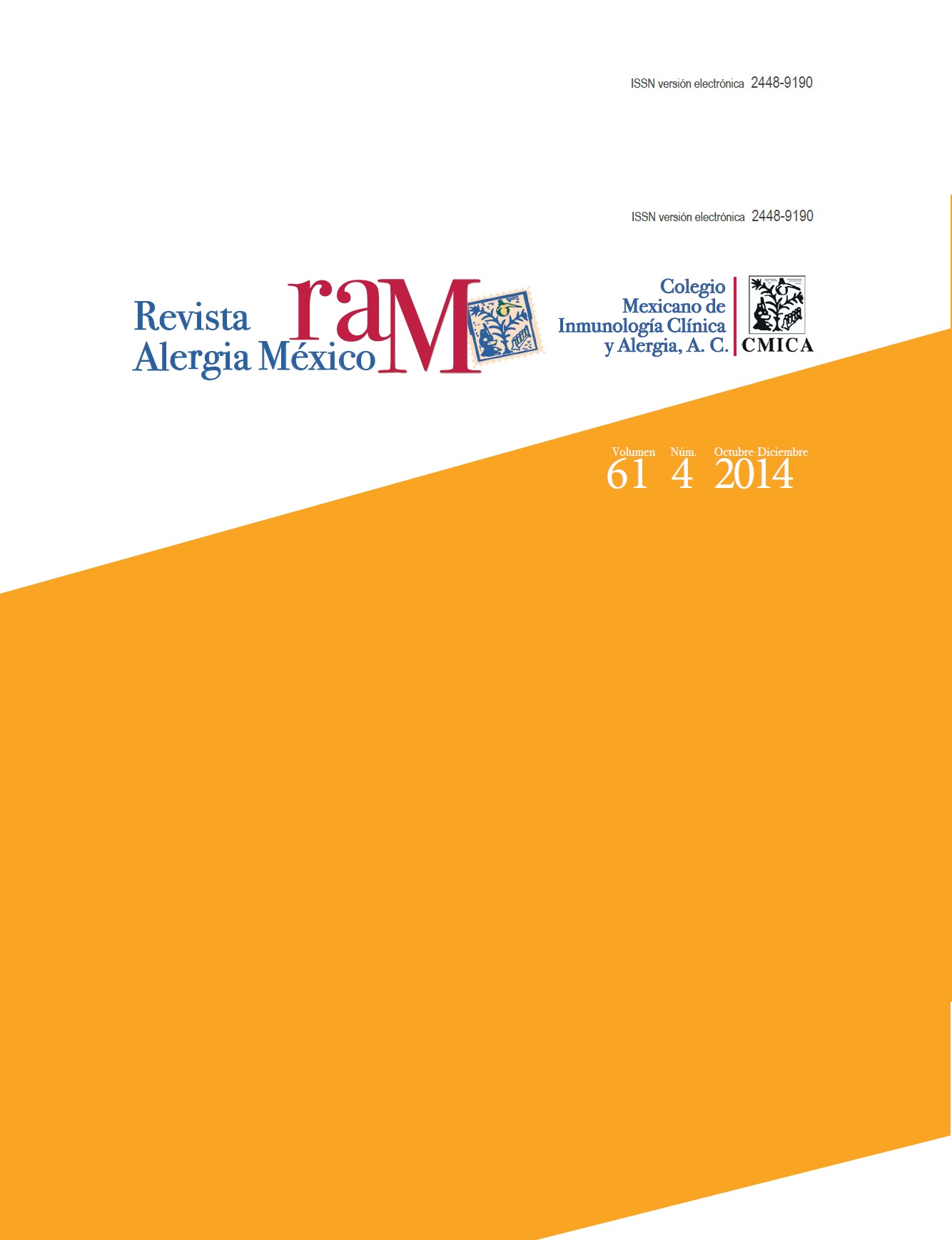Resumen
Antecedentes: la rinitis alérgica y el asma bronquial son procesos inflamatorios crónicos de las vías respiratorias, con una correlación que varía entre 28 y 78%.
Objetivos: determinar la prevalencia de rinitis alérgica en pacientes asmáticos y clasificarla según las guías Rinitis Alérgica y su Impacto en Asma (ARIA), así como detectar las concentraciones séricas de IgE total y la existencia de eosinofilia nasal y en sangre periférica.
Material y método: estudio en el que pacientes asmáticos entre 7 y 14 años de edad, consultantes del servicio de Pediatría del Hospital General del Sur Dr. Pedro Iturbe, Maracaibo, Estado Zulia, Venezuela, fueron encuestados acerca de signos y síntomas sugerentes de rinitis alérgica y su efecto en la calidad de vida. Se tomaron muestras sanguíneas e hisopado nasal para hacer las determinaciones objeto de estudio.
Resultados: se evaluaron 60 pacientes asmáticos, 73.3% del sexo masculino y 70% escolares. La prevalencia de rinitis alérgica se estableció en 93.3%, el tipo más frecuente según ARIA fue el intermitente leve, con 42.8%. El signo clínico más frecuente fueron las ojeras alérgicas (86.6%) y el síntoma predominante fue el goteo nasal acuoso (83.3%), la afectación en cuanto a calidad de vida estuvo representada por trastornos del sueño (39.2%). El 85.7% de los encuestados tuvo porcentajes de eosinófilos mayores a 3% y 75% tuvo valores mayores de 100 UI de IgE total sérica. El 61.9% de las muestras de moco nasal de pacientes con rinitis mostró porcentajes de eosinófilos mayores a 10%.
Conclusión: existe alta prevalencia de rinitis alérgica en asmáticos confirmada mediante pruebas de laboratorio que evidencian una respuesta inflamatoria mediada por IgE.
Referencias
Bousquet J, Khaltaev N, Cruz AA, Denburg J, et al. Allergic Rhinitis and its Impact on Asthma (ARIA) 2008 update (in collaboration with the World Health Organization, GA(2) LEN and AllerGen). Allergy 2008;63:8-160.
Ellwood P, Asher M, Beasley R, Clayton TO, et al. International Study of Asthma and Allergies in Childhood (ISAAC): Phase Three rationale and method. Int J Tuberc Lung Dis 2005;9:10-16.
Koh Y, Kim C. The development of asthma in patients with allergic rhinitis. Curr Opin Allergy Clin Immunol 2003;3:159-164.
Bateman E, Hurd S, Barnes P, Bousquet J, et al. Global strategy for asthma management and prevention: GINA executive summary. Eur Respir J 2008;31:143-178.
Bousquet J, Schünemann HJ, Samolinski B, Demoly P, et al. Allergic Rhinitis and its Impact on Asthma (ARIA): Achievements in 10 years and future needs. J Allergy Clin Immunol 2012;130:1049-1062.
Tu YL, Chang SW, Tsai HJ, Chen LC, et al. Total serum IgE in a population-based study of Asian children in Taiwan: reference value and significance in the diagnosis of allergy. Plos One 2013;8:1-9.
Carosso A, Bugiani M, Migliore E, Anton JM, DeMArco R. Reference values of total serum IgE and their significance in the diagnosis of allergy in young European adults. Int Arch Allergy Immunol 2007;142:230-238.
Levin M, Le Souëf P, Motala C. Total IgE in urban Black South African teenagers: the influence of atopy and helminth infection. Pediatr Allergy Immunol 2008;19:449-454.
Vallejo G, Téllez R, González A, Mena AJC, Reynoso DVM. Implicaciones de los eosinófilos en el moco nasal de pacientes con diagnóstico posible de rinitis alérgica. An Orl Mex 2007;52:58-62.
Matsuno O, Miyazaki E, Takenaka R, Ando MN, et al. Links between bronchial asthma and allergic rhinitis in the Oita Prefecture Japan. J Asthma 2006;43:165-167.
Hong S, Son DK, Lim WR, Kim SH, et al. The prevalence of atopic dermatitis, asthma, and allergic rhinitis and the comorbidity of allergic diseases in children. Environ Health Toxicol 2012;27:2-8.
De Freitas HA, Rodríguez-Galafat J, Mujica L, De Freitas MT. Asociación entre rinitis alérgica y asma. Rev Fac Med 2009;32:7-10.
Wang ZH, Lin WS, Li SY, Zhao SC, et al. Analysis of the correlation of prevalence in allergic rhinitis and other allergic diseases. Zhonghua Er Bi Yan Hou Tou Jing Wai Ke Za Zhi 2012;47:379-382.
Han Y, Zhang H. Epidemiological investigation of allergic rhinitis in the primary school students in grade three of Shihezi city. Lin Chung Er Bi Yan Hou Tou Jing Wai Ke Za Zhi 2009;23:1074-1078.
Penaranda A, Aristizabal G, Garcia E, Vasquez C, et al. Allergic rhinitis and associated factors in schoolchildren from Bogota, Colombia. Rhinology 2012;50:122-128.
Ibero M, Justicia JL, Alvaro M, Asensio O, et al. Diagnosis and treatment of allergic rhinitis in children: results of the PETRA study. Allergol Immunopathol 2012;40:138-143.
Lee CH, Jang JH, Lee HL, Kim IT, et al. Clinical characteristics of allergic rhinitis according to allergic rhinitis and its impact on asthma guidelines. Clin Exp Otorhinolaryngol 2008;1:196-200.
Kumar N, Bylappa K, Ramesh AC, Swetha R, et al. A study of eosinophil count in nasal and blood smear in allergic respiratory diseases in a rural setup. Internet J Med Update 2012;7:40-46.
Montoro J, Del Cuvillo A, Mullol J, Molina X, et al. Validation of the modified allergic rhinitis and its impact on asthma (ARIA) severity classification in allergic rhinitis children: the PEDRIAL study. Allergy 2012;67:1437-1442.
Zicari AM, Indinnimeo L, De Castro G, Incorvaia C, et al. A survey on features of allergic rhinitis in children. Curr Med Res Opin 2013;29:415-420.
Sha JC, Zhu DD, Dong Z, Jian XD, et al. Survey on clinical characteristics of pediatric allergic rhinitis. Zhonghua Er Bi Yan Hou Tou Jing Wai Ke Za Zhi 2011;46:26-30.
Ahmadiafshar A, Taghiloo D, Esmailzadeh A, Falakaflaki D. Nasal eosinophilia as a marker for allergic rhinitis: a controlled study of 50 patients. Ear Nose Throat J 2012;91:122-124.
Gelardi M, Incorvaia C, Fiorella ML, Quaranta N, et al. The clinical stage of allergic rhinitis is correlated to inflammation as detected by nasal cytology. Inflamm Allergy Drug Targets 2011;10:472-476.
Meng CD, Dong Z, Sha JC, Li L, Zhu DD. Analysis of the lever and significance of immunoglobulin free light chain in nasal secretion and in serum of patients with allergic rhinitis and non-allergic rhinitis. Zhonghua Er Bi Yan Hou Tou Jing Wai Ke Za Zhi 2012;47:908-912.

Esta obra está bajo una licencia internacional Creative Commons Atribución-NoComercial 4.0.
Derechos de autor 2014 Revista Alergia México





